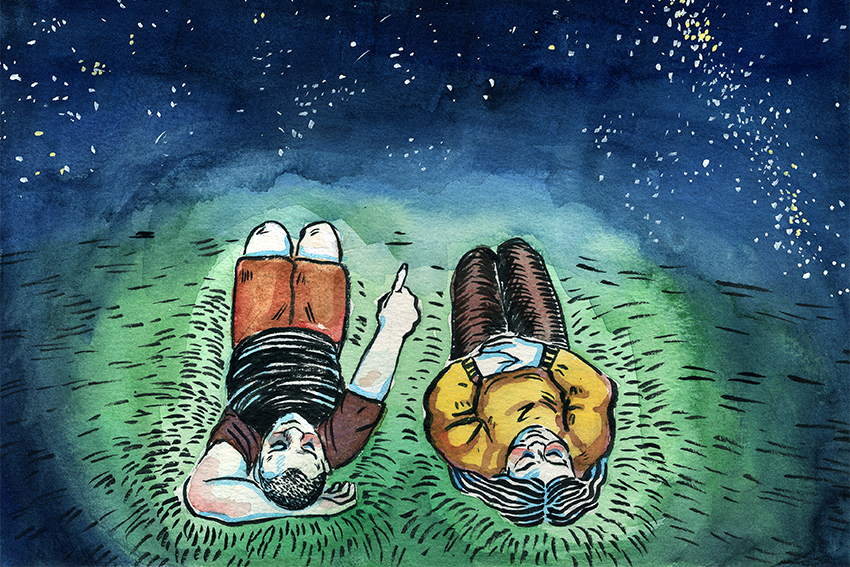There’s no party like a star party! Grab a picnic blanket and a few friends and catch some of the stellar night sky events this autumn.
What to Look For
Late fall and early winter nights will provide views of a number of meteor showers that can be seen with the naked eye.
“Meteors, commonly called shooting stars, are actually debris thrown off by comets as they orbit the Sun,” said Rebecca Johnson, UT journalism alumnus and editor of the UT McDonald Observatory’s stargazing magazine, StarDate. “When Earth passes through the orbit of a comet, some of this comet debris hits our atmosphere, burning up as it falls.”
Kelly Gibson, a public affairs specialist at the McDonald Observatory, said the Southern Taurids meteor shower can be seen this fall. This meteor shower began on September 10 and can be witnessed through November 20.
“This particular annual meteor shower, associated with a stream of debris left by comet Encke, is renowned for producing brilliant bolides [fireballs],” Gibson said.
Johnson said two other meteor showers will also take place this year: the Leonids on November 16 and the Geminids on December 13. The Gemini Shower will take place during a full moon, but it can still be viewed if the weather allows.
The UT telescopes will be set to view planets Uranus and Neptune this fall, as well as star clusters, binary star systems, and the Ring Nebula, according to UT astronomy alumna Lara Eakins, who organizes stargazing events.
A binary star system occurs when two stars are close enough together that their gravitational fields interact, causing them to orbit one another. One of the binary star systems UT telescopes plan to view is called Albireo.
“When you look at [Albireo] with a telescope, you actually see two stars, one blue and one yellow,” Eakins said. “This is a great pair for discussing the science behind why some stars are different colors — the blue one is very hot and the yellow one is just a little cooler than our Sun.”
Eakins said she and other volunteers attend star parties so they can explain what people can see through telescopes, and answer questions from attendees.
Star Parties and Organizations
UT hosts free star parties three nights a week for most of the school semester, Eakins said. The RLM building telescope allows public viewing every Wednesday starting at 8:00 p.m. before daylight savings ends on November 6, and starting at 7:00 p.m. afterwards. T. S. Painter Hall also has a telescope, which is open for public viewing on Fridays and Saturdays during the same hours as the telescope at RLM.
McDonald Observatory, located in the Davis Mountains 450 miles from Austin, has one of the world’s largest telescopes and provides star parties and other outreach events throughout the year, according to Gibson. The telescope is used for both research and public enjoyment. Gibson said the area around the telescope is notably good for stargazing because it is removed from most cities, which allows for darker skies and clearer views.
Austin Parks and Recreation, Austin Astronomical Society and UT’s Astronomy Student Association all provide outreach events and night sky viewing opportunities. Local and state parks around Austin, such as Enchanted Rock and Wild Basin Wilderness Preserve, are great locations to view the night sky, Eakins said.
Some celestial bodies can be seen without a high-powered telescope, Johnson said. Under good conditions Jupiter and Saturn, as well as some of their moons, can be seen with just a pair of binoculars. Johnson also said she recommends using a sky map and a pair of binoculars to find star clusters and nebulae.
When to Go
The best nights to go stargazing are clear, dark and dry, especially after a cold front, Eakins said. Humidity, pollen, smog and wind can scatter and distort light, making distant things more difficult to see.
“A bright moon can wash out dimmer things in the sky, so keep that in mind,” Johnson said. “A clear horizon, devoid of buildings and trees, means there is more sky for you to see.”
Even in cities like Austin, there is still much to see in the sky, Gibson said. Stars and relatively bright deep space objects can still be seen in imperfect conditions.
“Astronomy is a broad field with myriads of wonders, contests, curiosities and mysteries; it is the ultimate nexus of knowledge and understanding,” Gibson said. “We can leverage this enhanced understanding to shape the universe around us.”















